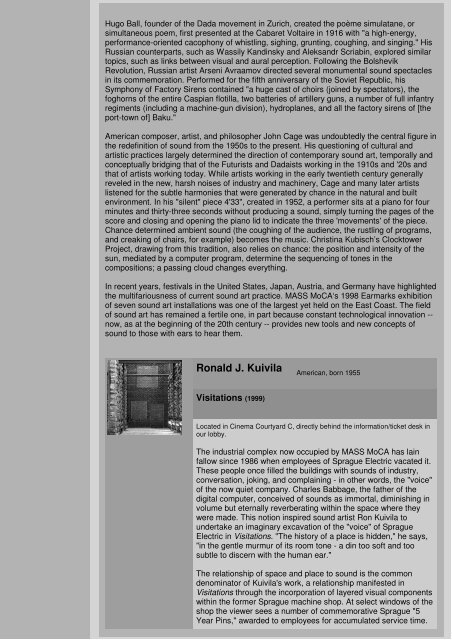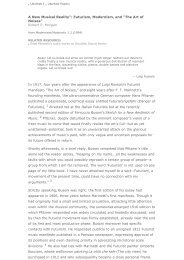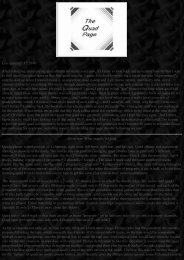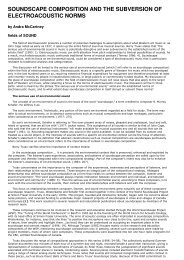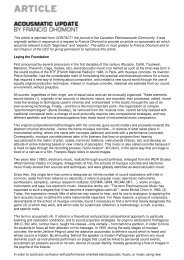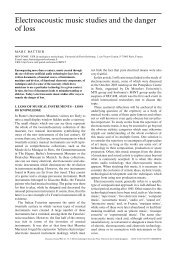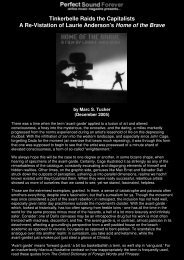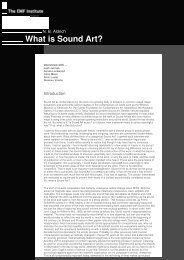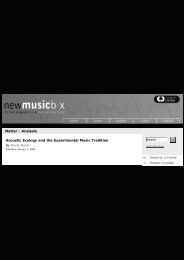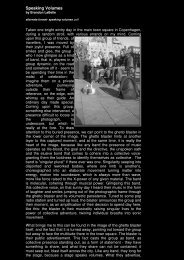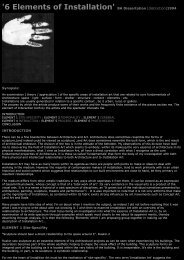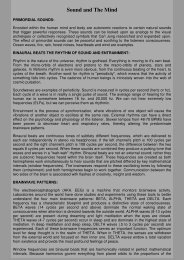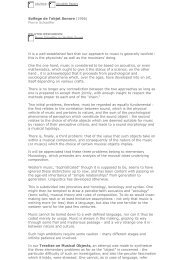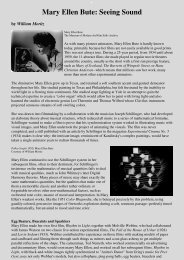MASS MoCA | Visual Arts | Sound Art - An International Archive of ...
MASS MoCA | Visual Arts | Sound Art - An International Archive of ...
MASS MoCA | Visual Arts | Sound Art - An International Archive of ...
Create successful ePaper yourself
Turn your PDF publications into a flip-book with our unique Google optimized e-Paper software.
Hugo Ball, founder <strong>of</strong> the Dada movement in Zurich, created the poème simulatane, or<br />
simultaneous poem, first presented at the Cabaret Voltaire in 1916 with "a high-energy,<br />
performance-oriented cacophony <strong>of</strong> whistling, sighing, grunting, coughing, and singing." His<br />
Russian counterparts, such as Wassily Kandinsky and Aleksandr Scriabin, explored similar<br />
topics, such as links between visual and aural perception. Following the Bolshevik<br />
Revolution, Russian artist Arseni Avraamov directed several monumental sound spectacles<br />
in its commemoration. Performed for the fifth anniversary <strong>of</strong> the Soviet Republic, his<br />
Symphony <strong>of</strong> Factory Sirens contained "a huge cast <strong>of</strong> choirs (joined by spectators), the<br />
foghorns <strong>of</strong> the entire Caspian flotilla, two batteries <strong>of</strong> artillery guns, a number <strong>of</strong> full infantry<br />
regiments (including a machine-gun division), hydroplanes, and all the factory sirens <strong>of</strong> [the<br />
port-town <strong>of</strong>] Baku."<br />
American composer, artist, and philosopher John Cage was undoubtedly the central figure in<br />
the redefinition <strong>of</strong> sound from the 1950s to the present. His questioning <strong>of</strong> cultural and<br />
artistic practices largely determined the direction <strong>of</strong> contemporary sound art, temporally and<br />
conceptually bridging that <strong>of</strong> the Futurists and Dadaists working in the 1910s and '20s and<br />
that <strong>of</strong> artists working today. While artists working in the early twentieth century generally<br />
reveled in the new, harsh noises <strong>of</strong> industry and machinery, Cage and many later artists<br />
listened for the subtle harmonies that were generated by chance in the natural and built<br />
environment. In his "silent" piece 4'33", created in 1952, a performer sits at a piano for four<br />
minutes and thirty-three seconds without producing a sound, simply turning the pages <strong>of</strong> the<br />
score and closing and opening the piano lid to indicate the three 'movements' <strong>of</strong> the piece.<br />
Chance determined ambient sound (the coughing <strong>of</strong> the audience, the rustling <strong>of</strong> programs,<br />
and creaking <strong>of</strong> chairs, for example) becomes the music. Christina Kubisch’s Clocktower<br />
Project, drawing from this tradition, also relies on chance: the position and intensity <strong>of</strong> the<br />
sun, mediated by a computer program, determine the sequencing <strong>of</strong> tones in the<br />
compositions; a passing cloud changes everything.<br />
In recent years, festivals in the United States, Japan, Austria, and Germany have highlighted<br />
the multifariousness <strong>of</strong> current sound art practice. <strong>MASS</strong> <strong>MoCA</strong>‘s 1998 Earmarks exhibition<br />
<strong>of</strong> seven sound art installations was one <strong>of</strong> the largest yet held on the East Coast. The field<br />
<strong>of</strong> sound art has remained a fertile one, in part because constant technological innovation --<br />
now, as at the beginning <strong>of</strong> the 20th century -- provides new tools and new concepts <strong>of</strong><br />
sound to those with ears to hear them.<br />
Ronald J. Kuivila<br />
American, born 1955<br />
Visitations (1999)<br />
Located in Cinema Courtyard C, directly behind the information/ticket desk in<br />
our lobby.<br />
The industrial complex now occupied by <strong>MASS</strong> <strong>MoCA</strong> has lain<br />
fallow since 1986 when employees <strong>of</strong> Sprague Electric vacated it.<br />
These people once filled the buildings with sounds <strong>of</strong> industry,<br />
conversation, joking, and complaining - in other words, the "voice"<br />
<strong>of</strong> the now quiet company. Charles Babbage, the father <strong>of</strong> the<br />
digital computer, conceived <strong>of</strong> sounds as immortal, diminishing in<br />
volume but eternally reverberating within the space where they<br />
were made. This notion inspired sound artist Ron Kuivila to<br />
undertake an imaginary excavation <strong>of</strong> the "voice" <strong>of</strong> Sprague<br />
Electric in Visitations. "The history <strong>of</strong> a place is hidden," he says,<br />
"in the gentle murmur <strong>of</strong> its room tone - a din too s<strong>of</strong>t and too<br />
subtle to discern with the human ear."<br />
The relationship <strong>of</strong> space and place to sound is the common<br />
denominator <strong>of</strong> Kuivila's work, a relationship manifested in<br />
Visitations through the incorporation <strong>of</strong> layered visual components<br />
within the former Sprague machine shop. At select windows <strong>of</strong> the<br />
shop the viewer sees a number <strong>of</strong> commemorative Sprague "5<br />
Year Pins," awarded to employees for accumulated service time.


